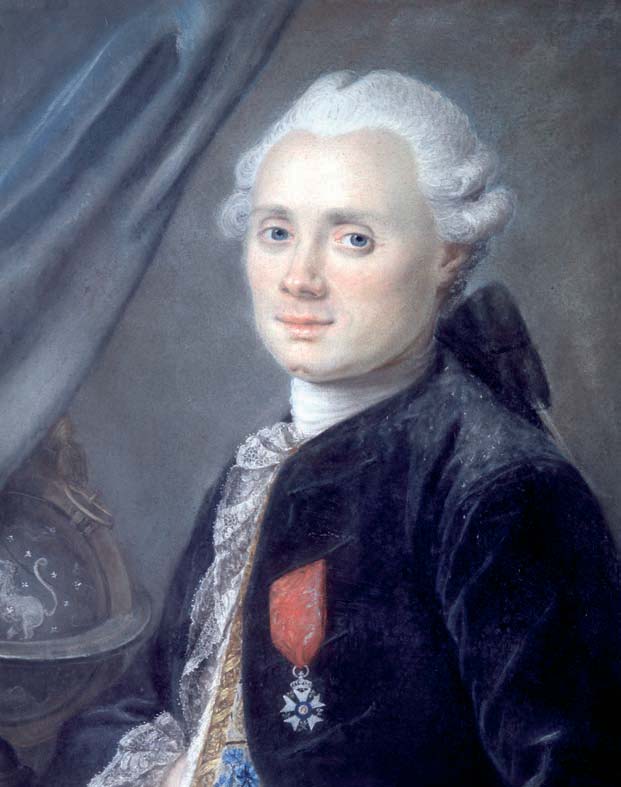
Caption: Charles Messier (1730--1817) circa 1770---looking très Ancien Regime.
Features:
- Messier, who was
the observing assistant at the
Hotel de Cluny Observatory
(AKA Marine Observatory) in
Paris
(No-403--404)
(which is NOT same thing as
the Paris Observatory),
made a determined
effort to discover all the brightest
nebulae (historical usage)
(No-403--404).
- From his discoveries,
he compiled a what we call the
Messier catalog
of the brightest and largest
nebulae (historical usage).
The word
nebulae (historical usage)
used here in the historical sense: i.e., to mean cloudy-looking
astronomical object.
In modern times, we
know that
nebulae (historical usage)
are 3 different things:
- actual clouds of interstellar medium (ISM): i.e., clouds of interstellar gas and/or interstellar dust.
- clusters of stars inside the Milky Way.
- other galaxies
outside of the
Milky Way.
- The final published version of
the Messier catalog
contained
103
nebulae (historical usage),
but several others were added in Messier's
notes, and so today there
are conventionally 110
Messier objects
(Wikipedia: Messier object):
M1 (Crab nebula, supernova remnant NGC 1952),
M2 (globular cluster, NGC 7089),
M3 (globular cluster, NGC 5272), ... ,
M31 (Andromeda Galaxy,
barred spiral galaxy, NGC 224),
M32 (dwarf elliptical galaxy, NGC 221),
M33 (Triagulum Galaxy,
unbarred spiral galaxy, NGC 598), ... ,
M87 (supergiant elliptical galaxy, NGC 4486), ... ,
M101 (Pinwheel Galaxy,
unbarred spiral galaxy, NGC 5457), ... ,
M110 (dwarf elliptical galaxy, NGC 205).
Note, like many astronomical objects the Messier objects often have alternative names. Some of them have special proper names (e.g, M1 is also the Crab nebula) and they probably all have NGC (New General Catalogue) numbers: (e.g., M31 is also NGC 224).
- There are, of course, a quasi-infinity of
nebulae (historical usage)
in the observable universe.
But Messier catalog
contains just about all the brightest and largest
nebulae (historical usage)
as seen from the Earth, and so are especially important
astronomical objects for
both amateur astronomy
and professional astronomy.
- Messier
was actually interested in discovering
comets and he discovered
14 of them
(Wikipedia: Charles Messier: Biography).
He compiled the Messier catalog to eliminate false positives in comet discovery.
To explicate: Comets when they do NOT have obvious comet tails, strongly resemble nebulae (historical usage): both kind of astronomical objects are fuzzy little clouds if NOT looked at too closely. So a nebula (historical usage) can give a false positive for a comet if you do NOT have a catalog of bright nebulae (historical usage) handy to eliminate it as potential comet.
- In fact, Messier
probably could NOT detect relatively dim
comets
NOR nebulae
since he used a 10-centimeter (∼ 4-inch)
refractor telescope
which had very low
light-gathering power
(see Wikipedia:
Charles Messier: Messier catalogue)
compared to the
18.5-inch (47.0 cm)
reflector telescope which
William Herschel (1738--1822)
(aided by his sister
Caroline Herschel (1750--1848))
probably used in finding most of the ∼ 2400
nebulae (historical usage)
he had found by the end of his career
(Wikipedia: William Herschel:
Deep sky surveys;
Wikipedia:
William Herschel: Works with his sister Caroline Herschel;
Wikipedia:
William Herschel: Herschel's telescopes).
Recall
light-gathering power
scales as the
square of the
objective
(primary lens/primary mirror).
So Herschel's
reflector telescope
had ∼ 21.4 times more
light-gathering power
than Messier's
refractor telescope.
- Messier's
ultimate fame
is NOT for what he thought it would be---who cares who discovered
18th century
comets---other
than who was the eponymous
discoverer of Halley's comet---who
was
you know who---and,
of course, who was
Caroline Herschel (1750--1848):
-
And when I have finished all my other work, I sweep the
sky.
-
---Caroline Herschel (1750--1848)
quote from somewhere.
Perhaps, apocryphal.
Image link: Wikipedia: File:Charles Messier.jpg.
Local file: local link: charles_messier.html.
File: Astronomer file: charles_messier.html.